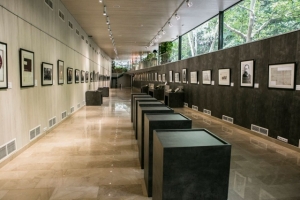Ministry of Justice Opens New Exhibition Space
A new exhibition gallery has opened at the National Archives of Georgia’s Ministry of Justice displaying manuscripts and historical documents of 9-19th centuries and other historical materials.
Besides exhibition projects, the new gallery will hold open lectures, educational projects and presentations of various publications. It also has a media library with a collection of unique books, access to computers and the Internet. In the near future, the Ministry of Justice plans to open a bookstore which will sell various publications prepared based on archival materials, and national souvenirs.
The gallery was opened with the “Our Archive is Our Treasure” exhibition, which presented diverse historical and cultural exhibits from the National Archives’ collections. Among them are historical documents which reflect the national liberation movement of the 19th century, archival material, the first documents of the Georgian Democratic Republic, as well as photographs and written documents of the Soviet period and a documentary chronicle of the 1990s.
The National Archives of Georgia is the biggest repository of ancient documents in the country. It keeps up to 5 million documents, including 439,063 photos, more than 55,000 phonon and film documents, and up to 80,000 books and 50,000 periodicals.
“This gallery is a long-term project that will be able to revive the industrial center of Tbilisi – the Saburtalo district,” said Thea Tsulukiani, the Minister of Justice of Georgia at the gallery’s opening. “We hope that it will be of interest not only for locals but also for tourists as we present interesting and unique exhibits.”
The most ancient manuscripts preserved in the National Archives of Georgia were included in the register of UNESCO’s Memory of the World program in 2015, which is aimed at protecting the world's documentary heritage.
The Minister added that since the National Archives’ opening in 1920, it never before had its own exhibition space for cultural and educational activities. The gallery is built next to the Archive building, at the intersection of Vazha Pshavela Avenue and Pekini Street. Entrance is free of charge.
Eka Karsaulidze











